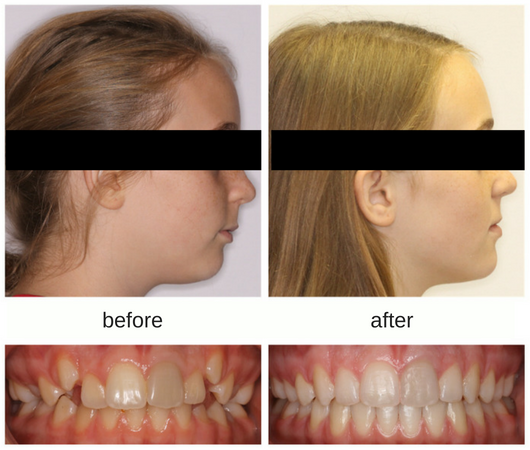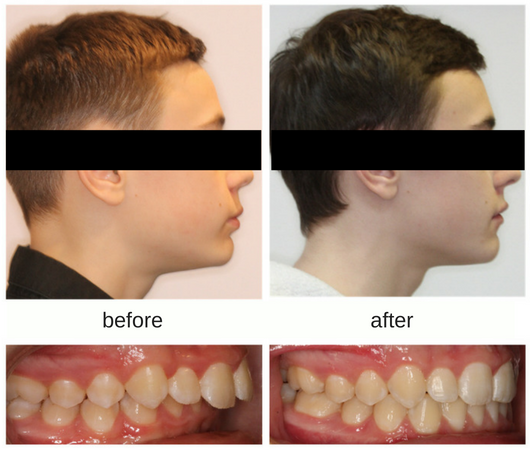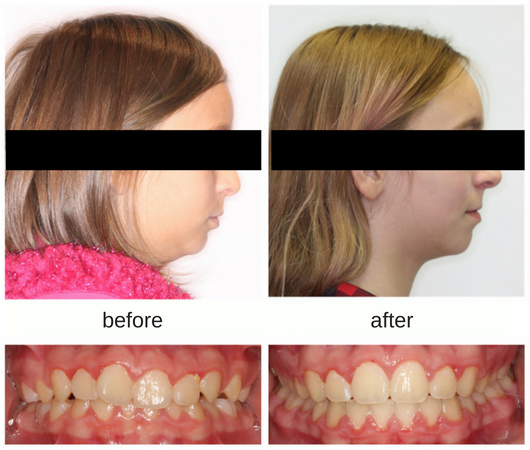Recessive Lower Jaw
We often have parents calling our office worried about their son or daughter’s recessive lower jaw. One of the best things that a parent can do is bring their child in early for orthodontic assessment to resolve issues with growth of the jaws and eruption of the teeth. The American Association of Orthodontists recommends that children have their first visit to the orthodontist by age 7. A recessive jaw is something that we can help correct early.
What is a recessive lower jaw?
A recessive lower jaw, also known as mandibular retrognathia, is a type of malocclusion or “poor bite” that occurs when the lower jaw has not grown enough compared to the upper jaw. A recessive lower jaw will result in overjet which is defined as the horizontal relationship of the upper and lower teeth. This is not to be confused with overbite, which is the vertical overlap between the upper and lower teeth. Patients with recessive lower jaws will often present with overjet and overbite.
In a patient with a normal bite, the lower front teeth are usually in light contact with the back of the upper front teeth. In patients with recessive lower jaws, the lower front teeth contact behind the upper front teeth and sometimes, in severe cases, on the roof of the mouth. This gives the impression of the upper front teeth sticking out beyond the lower teeth. Again, the horizontal distance between the upper and lower teeth is known as overjet. The smaller and more recessive the lower jaw, the greater the overjet. If severe, the lower lip will curl in the gap between the upper and lower teeth causing a fold between the chin and the lower lip resulting in a weak chin. Just like underbites, the overjet that is present with a recessive lower jaws can vary in severity from mild or barely noticeable to severe, where there is a significant distortion of facial features and may create self-esteem issues in the future.
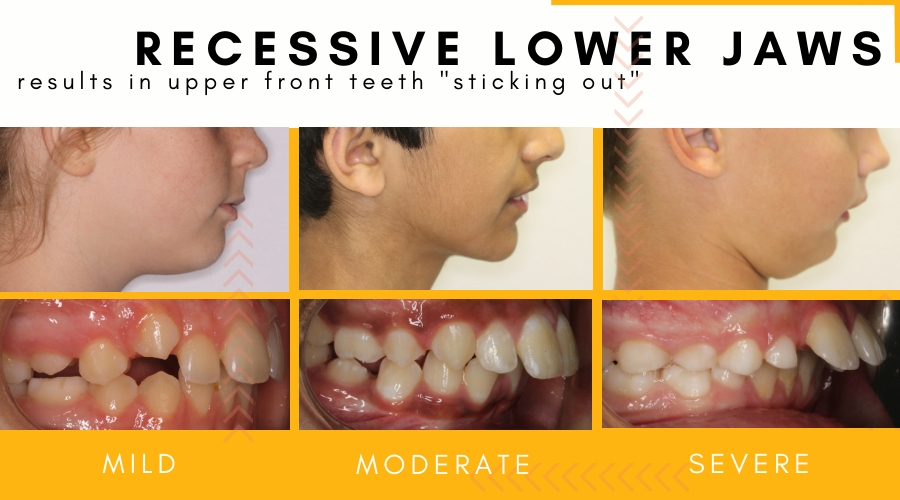
What are the causes of a recessive lower jaw?
Genetics is a major factor in recessive lower jaws. This type of bite is frequently seen in the population – in fact it is the most commonly treated malocclusion in our Mississauga office. The good news is that if a patient is seen early enough, orthodontists can help with modifying the growth of the jaws so that complicated and invasive surgical procedures can be avoided in the future.
Complications of recessive lower jaws
- Difficulty chewing
- Poor bite and tooth alignment
- Chronic jaw or joint (TMJ) pain and other issues with joints
- Difficulty breathing especially during sleep or when lying on one’s back
- Sleep apnea, snoring and other night time breathing difficulties
- Self esteem issues
When do you treat recessive lower jaws in younger children?
In our office, we follow an evidence based approach to treatment of recessive lower jaw. Studies have shown that the best time to treat patients with recessive lower jaws is right before their pubertal growth spurt. There are certain physiological indicators that orthodontists are trained to notice both in their patient’s physical development and from x-rays that give us clues as to when a patient will be going through their final growth spurt.
When a patient enters puberty, there are certain growth factors and hormones present that not only help them to grow taller and develop more muscle tissue, but also help to stimulate the growth of the lower jaw. Because of this, we will not normally start this type of treatment in younger children who are a few years away from puberty (ages 7-9). However, we are finding that more and more patients are undergoing puberty at an earlier age. In fact, in girls, the beginning of the pubertal growth spurt can occur before the patient even looses all their baby teeth. As a result we may start treatment to help the lower jaw grow first while we can take advantage of growth and finish off with braces once the adult teeth have erupted. In comparison to girls, we will initiate treatment for boys with recessive jaws closer to their growth spurt, at around age 13-15 years. At this time most or all of their adult teeth have erupted which means they can be treated simultaneously with braces and growth modification appliances.
Once a patient has passed their growth spurt, and there is no growth potential left, it is very difficult to correct their bite and profile using appliances. Instead, surgical options or extraction of teeth may have to be considered.
What appliances do you use to correct a recessive lower jaw in younger children?
We often use orthopedic appliances (devices that help growth) as opposed to orthodontic appliances (devices that move teeth) when a patient’s lower jaw has not grown enough. Most of these appliances are semi-permanent, which means they are fixed on to the teeth. These include the Herbst appliance, Japer Veckor appliance, Mara Appliance, AdvanceSync Appliance and Crossbow Appliance.
Removable appliances are available as well and include the Twin Block, Monoblock and Bionator. Unfortunately, several studies have shown removable appliances to be less effective at helping the lower jaw grow. These appliances are large and cumbersome, they often are hard to speak and function with (yes, your child has to wear them to school), and they usually have a poor fit – its no wonder kids don’t wear them!
Studies have shown that the clinical effectiveness of semipermanent appliances is far superior than removable appliances – which is why, Dr. Virdee will always recommend the appliance that will give you the best results – a fixed Herbst appliance. There are many versions of the Herbst appliance, some that include an expander or a stabilizing bar across the upper jaw, or some that have a bar in front of the lower incisors. Regardless of the permutations of this appliance, they have one major function: to help with the growth of the lower jaw.
What is a Herbst appliance?
A Herbst appliance is securely fastened to your child’s teeth and includes metal tubes that connect the upper and lower jaw. By adjusting the tube, we are able to control the growth of the jaw. The Herbst appliance is more comfortable than most removable appliances – it is streamlined, discreet and may only be visible when your child laughs or speaks.
How long is treatment with a Herbst appliance?
Treatment time with the Herbst appliance is usually 1 year, though this may vary depending on the child’s unique needs. If your child has their adult teeth by the time the appliance is removed we will continue with braces, otherwise there will be a rest period between phase I treatment and phase II treatment. By taking advantage of growth when a patient is younger, it is possible to avoid complicated and invasive procedures like surgery or extraction of permanent teeth.
Adjusting to the Herbst appliance?
Like anything new, your child has to adjust to the Herbst appliance in their mouth. The good news is, because children are more resilient than adults, it’s easier for them to adapt to something new. It usually takes about a week to get used to eating, chewing and speaking with the appliance. Eating softer foods will help with the muscle tenderness that may occur in the first week or two as your child gets used to their appliance. It is important to eliminate sticky foods, like candy and gum or hard, crunchy foods which can damage the appliance and lengthen treatment time.
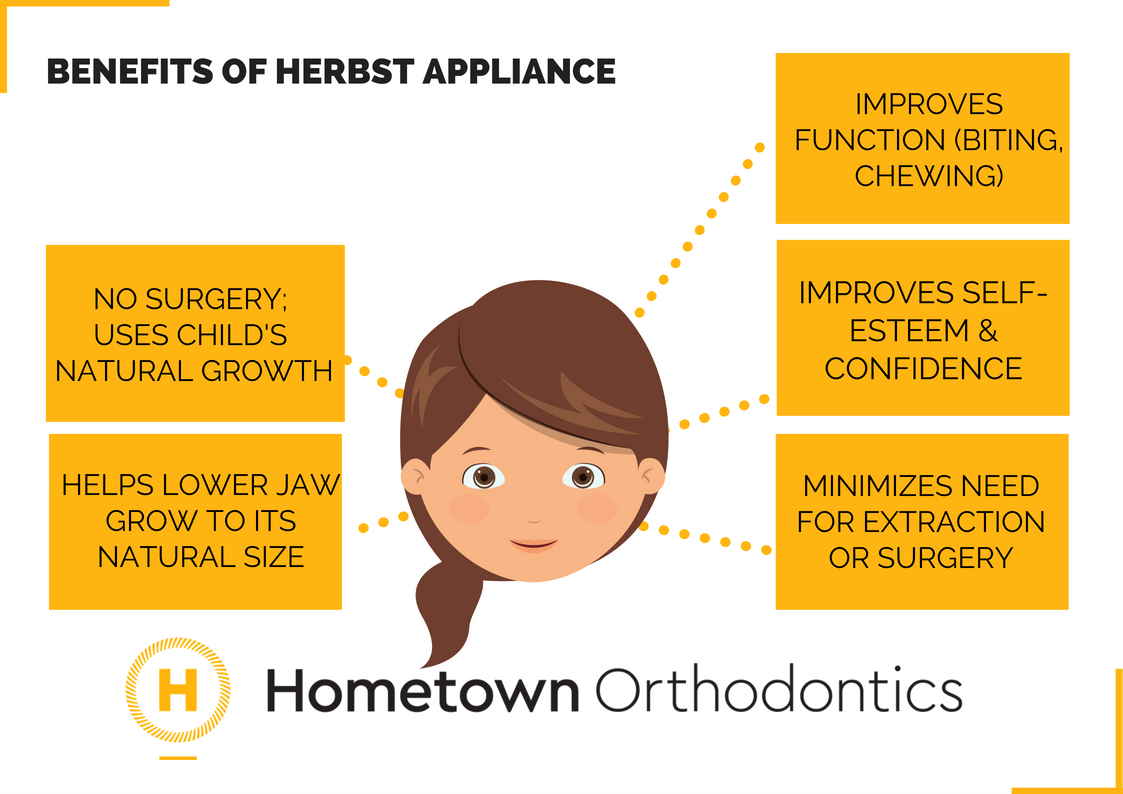
Headgear: A Case for Severe Lower Jaw Recession in Young Children
There is a class of younger patients with recessive lower jaws that we may treat early in our clinic. These patients are usually 7-10 years old and present with a severely recessive lower jaw, protrusive upper front teeth that flare out so much that they may have a hard time closing their lips around their teeth or their upper lips stays trapped behind their upper front teeth at rest.
In this case, Dr. Virdee may recommend partial braces with the headgear appliance. Remember overjet can be corrected by pushing the lower teeth forward so that they are closer to the upper front teeth (this is how the elastics and the Herbst appliance work) or by pushing the upper front teeth back so that they are closer to the lower front teeth. The headgear appliance is the only appliance that can shift the upper teeth back – the only catch is that it must be worn properly. Younger patients tend to wear this appliance very well and in cases where there is a combination of protrusion of the upper front teeth in combination with a recessive lower jaw, this is the perfect appliance!
How does Headgear help patients with recessive lower jaws?
The inner bow of headgear appliance is inserted into bands supported by the upper first year molars which are connected to the upper front teeth by an orthodontic wire. Once the elastic modules are connected to the outer bow of the headgear and attached to the neck strap a force is created that pulls the molar backwards. If the headgear is worn well, the upper first molar is slowly pushed distally or backwards dragging the rest of the teeth with it. This results in overjet reduction and retraction of the upper front teeth so that they are no longer sticking out. As a result, younger patients are able to then close their mouth around their teeth and obtain better smile esthetics. Because the treatment time for this appliance is approximately 10 months, if the appliance is worn well, you may also see some lower jaw growth as well, although it will not be to the same extent as that achieved during the pubertal growth spurt.
When is the Headgear Worn?
>
Headgear is usually worn for 12-14h per day to have beneficial effects. We ask that patients wear the headgear to bed and anytime they are in the house playing, doing homework, watching TV or playing video games. A patient DOES NOT have to wear the headgear to school, playdates, or sleepovers. The headgear appliance may have a bad reputation as orthodontists once made their patients wear it to school. However, dental professionals and orthodontists know that this appliance, if worn well, is actually the gold standard of orthodontic care as it has so many benefits and little side effects. In fact, Dr. Virdee treats several patients who are children of dentists and in cases where the patient presents with a moderate to severe class II bite, most dentists will opt for headgear for their children.
If you feel that your child has a recessive lower jaw, please contact our office for an initial consultation. Many parents think that the lower jaw can grow naturally. This may not always be the case. The best thing you can do for your child is to seek consultation from an orthodontist at an early age.
Click here to contact our office to schedule a consultation with Dr. Virdee today!
Smile Gallery
-

Katie
-

Noah
-

Tess
-

Kody
-

Tess
Get a Free Consultation
Make an appointment today and start your child’s journey to a healthy and beautiful smile with Hometown Orthodontics.




